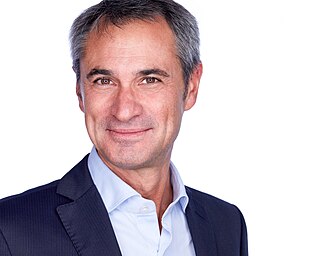
The École polytechnique fédérale de Lausanne is a public research university in Lausanne, Switzerland. Established in 1969, EPFL has placed itself as a public research university specializing in engineering and natural sciences.

The Smaky is a line of mostly 8-bit personal computers and accompanying operating system developed by Professor Jean-Daniel Nicoud and others at the École Polytechnique Fédérale de Lausanne (EPFL) in Switzerland beginning in 1974. The computers were used at École Polytechnique Fédérale de Lausanne and in Swiss schools. The names derives from SMArt KeYboard, reflecting the form factor that contained a compact motherboard which fit within the same housing as the keyboard.

The Khepera is a small (5.5 cm) differential wheeled mobile robot that was developed at the LAMI laboratory of Professor Jean-Daniel Nicoud at EPFL in the mid 1990s. It was developed by Edo. Franzi, Francesco Mondada, André Guignard and others.

André Guignard is a Swiss engineer initially educated as a watchmaker. He is the creator of the mechanic of the Khepera, the S-bot and several other mobile robots.

Dario Floreano is a Swiss-Italian roboticist and engineer. He is Director of the Laboratory of Intelligent System (LIS) at the École Polytechnique Fédérale de Lausanne in Switzerland and was the founding director of the Swiss National Centre of Competence in Research (NCCR) Robotics.

The AMD Am29000, commonly shortened to 29k, is a family of 32-bit RISC microprocessors and microcontrollers developed and fabricated by Advanced Micro Devices (AMD). Based on the seminal Berkeley RISC, the 29k added a number of significant improvements. They were, for a time, the most popular RISC chips on the market, widely used in laser printers from a variety of manufacturers.

Busicom Co., Ltd. was a Japanese company that manufactured and sold computer-related products headquartered in Taito, Tokyo. It owned the rights to Intel's first microprocessor, the Intel 4004, which they created in partnership with Intel in 1970.

The R3000 is a 32-bit RISC microprocessor chipset developed by MIPS Computer Systems that implemented the MIPS I instruction set architecture (ISA). Introduced in June 1988, it was the second MIPS implementation, succeeding the R2000 as the flagship MIPS microprocessor. It operated at 20, 25 and 33.33 MHz.

The NEC V60 is a CISC microprocessor manufactured by NEC starting in 1986. Several improved versions were introduced with the same instruction set architecture (ISA), the V70 in 1987, and the V80 and AFPP in 1989. They were succeeded by the V800 product families, which is currently produced by Renesas Electronics.

In robotics and computer vision, visual odometry is the process of determining the position and orientation of a robot by analyzing the associated camera images. It has been used in a wide variety of robotic applications, such as on the Mars Exploration Rovers.

René Sommer was a Swiss inventor and computer programmer, credited as a co-inventor of the computer mouse.
Alcherio Martinoli is a roboticist and an associate professor at the École polytechnique fédérale de Lausanne (EPFL) in the School of Architecture, Civil and Environmental Engineering where he heads the Distributed Systems and Algorithms Laboratory.

Sabine Hauert is Professor of Swarm Engineering in the Bristol Robotics Laboratory at the University of Bristol where her research investigates swarm robotics. Previously she worked at the Massachusetts Institute of Technology (MIT), Carnegie Mellon University (CMU) and the École Polytechnique Fédérale de Lausanne (EPFL) in Switzerland.
David Jaggar is a computer scientist who was responsible for the development of the ARM architecture between 1992 and 2000, redefining it from a low-cost workstation processor to the dominant embedded system processor.
Daniel Cremers is a German computer scientist, Professor of Informatics and Mathematics and Chair of Computer Vision & Artificial Intelligence at the Technische Universität München. His research foci are computer vision, mathematical image, partial differential equations, convex and combinatorial optimization, machine learning and statistical inference.

Aude G. Billard is a Swiss physicist in the fields of machine learning and human-robot interactions. As a full professor at the School of Engineering at Swiss Federal Institute of Technology in Lausanne (EPFL), Billard’s research focuses on applying machine learning to support robot learning through human guidance. Billard’s work on human-robot interactions has been recognized numerous times by the Institute of Electrical and Electronics Engineers (IEEE) and she currently holds a leadership position on the executive committee of the IEEE Robotics and Automation Society (RAS) as the vice president of publication activities.

Margarita Chli is an assistant professor and leader of the Vision for Robotics Lab at ETH Zürich in Switzerland. Chli is a leader in the field of computer vision and robotics and was on the team of researchers to develop the first fully autonomous helicopter with onboard localization and mapping. Chli is also the Vice Director of the Institute of Robotics and Intelligent Systems and an Honorary Fellow of the University of Edinburgh in the United Kingdom. Her research currently focuses on developing visual perception and intelligence in flying autonomous robotic systems.

Auke Jan Ijspeert is a Swiss-Dutch roboticist and neuroscientist. He is a professor of biorobotics in the Institute of Bioengineering at EPFL, École Polytechnique Fédérale de Lausanne, and the head of the Biorobotics Laboratory at the School of Engineering.

Niels Quack is a Swiss and German engineer specialized in optical micro engineering. He is a SNSF professor at EPFL and director of the Photonic Micro- and Nanosystems Laboratory at its school of engineering.
















